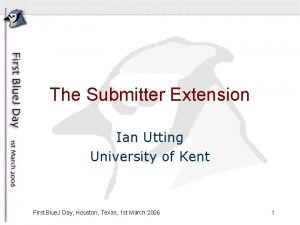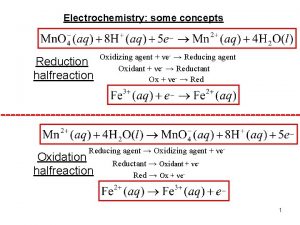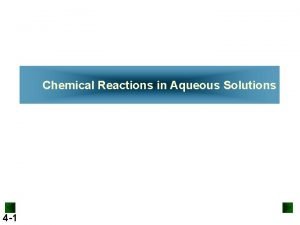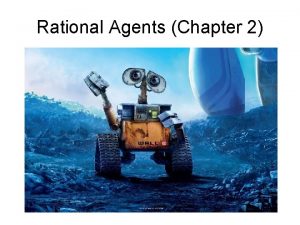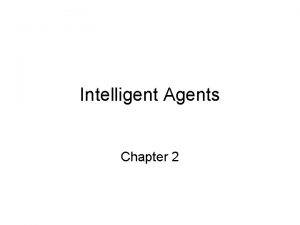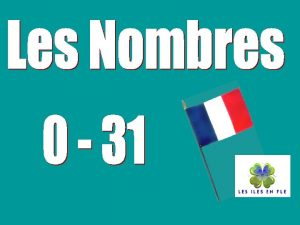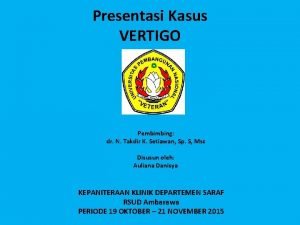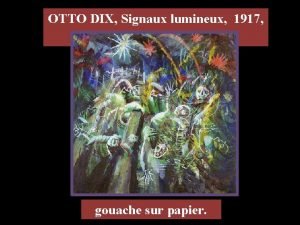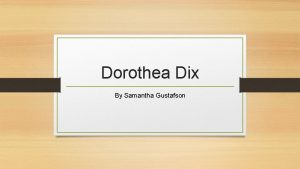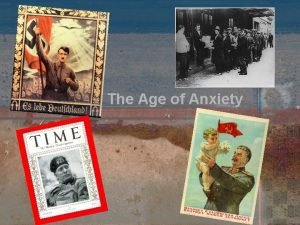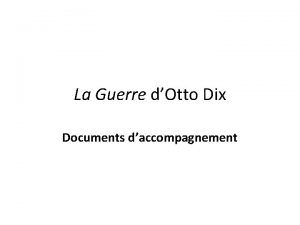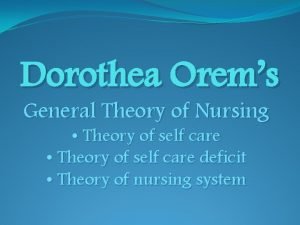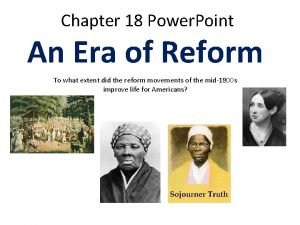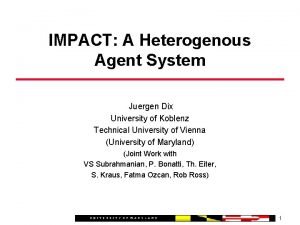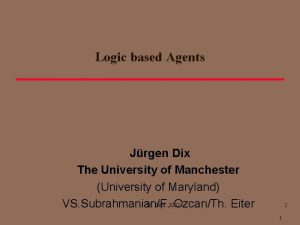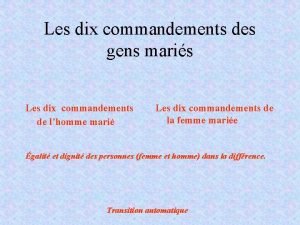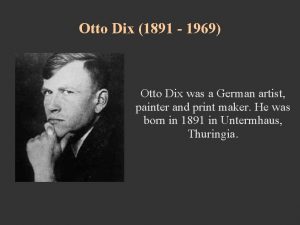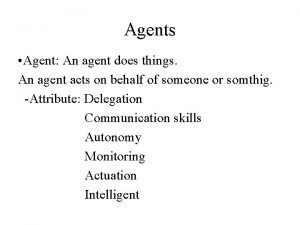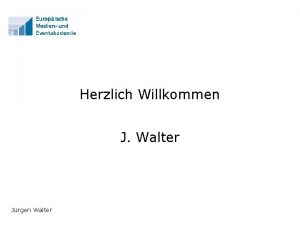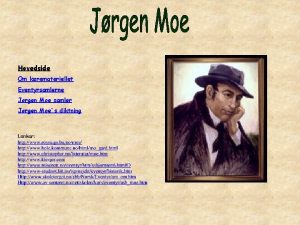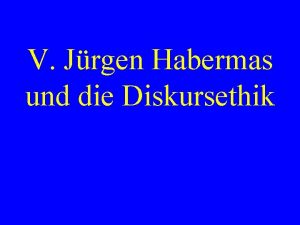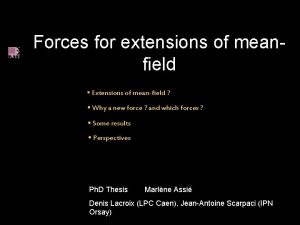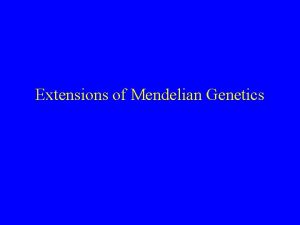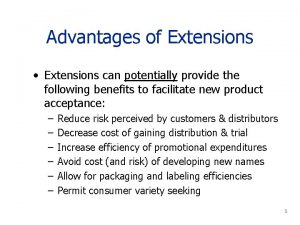IMPACT Agent Extensions Jrgen Dix University of MarylandUniversity






















- Slides: 22

IMPACT Agent Extensions Jürgen Dix University of Maryland/University of Koblenz joint work with Sarit Kraus (Bar-Ilan), VS Subrahmanian (Maryland) 1

Outline Meta Agents: Allow agents to reason about the beliefs and actions of other agents. Temporal Agents: Allow agents to execute actions that have temporal extent and to schedule actions for the future. Agents may reason about the past. Probabilistic Agents: Allow the agent to reason about uncertainty in the world. Motivating Example (RAMP) 1999 IMPACT Workshop 2

Additional Data Structures Agent maintains two kinds of tables: a belief table specifying the beliefs the agent has about other agents. This table contains information both about agent A’s beliefs about the state of another agent B, but also the actions of agent B, beliefs of agent B about other agents, . . . a belief semantics table specifying what the agent believes another agent uses for its own reasoning. 1999 IMPACT Workshop 3

Belief/ Belief Semantics Table Belief Table of agent heli 1: Agent heli 2 tank 1 Formula in(pos 2, heli 2: get. Pos()) in(pos 1, tank 1 : get. Pos()) tank 1 Beltank 1(heli 1, in(pos 2, heli 1 : get. Pos())), Literals of the form Bel. A(B, ), are called Belief literals: this says (informally) that agent A believes that in agent B’s state the formula holds. ( is a belief formula). Belief Semantics Table of agent heli 1: heli 2 acts according to Semfeas, tank 1 according to Semrat, 1999 IMPACT Workshop 4

Meta Agent Programs A meta-agent rule has the form Op a L 1 & … & Ln where each Li is either a – code call literal – action literal or – a belief literal of the form Bel. A(B, ). A meta-agent program is a finite set of meta-agent rules. 1999 IMPACT Workshop 5

Example Meta Agent Program If an enemy located at P 2 threatens a friendly force at P 1, the enemy should be attacked. Part of heli 1’s meta agent program: O attack(P 2) Belheli 1(heli 2, in(P 1, heli 2 : get. Pos() ) ), in(P 1, tracking: threatened(P 2) ) where tracking: threatened(P 2) gives all positions threatened by an enemy located in P 2. 1999 IMPACT Workshop 6

Key Results Developed a formal semantics of meta-agent programs. Key Theorem 1: Showed that when no beliefs are present, this semantics coincides with ordinary agent programs. Key Theorem 2: Developed a transformation that takes as input, a MAP, and produces as output, an ordinary agent program with extended data structures such that the semantics of the MAP coincides with the semantics of the translated agent program (with extra data structures). Above result provides a clean, efficient way of implementing MAPs within the Agent. DE framework. 1999 IMPACT Workshop 7

Temporal Agent Programs Ordinary agent programs: Each action is assumed to be instantaneously executable. Not valid for many actions, e. g. drive_from_to(dc, ny). Actions with temporal duration may have intermediate effects (e. g. driving a car from DC to NY, once started, constantly changes the location of the car). At time t, an agent computes a new status set S, and immediately executes conc({ a : DO a in S }). No easy way for the agent to schedule actions for the future (though in fact this can be expressed via some additional data structures). 1999 IMPACT Workshop 8

Checkpoint Expressions (cpe) Specify times when an action’s effects should be incorporated into the state. Two ways to do this relative checkpoints relative time-intervals since the start of the action absolute checkpoints specify absolute time points when the effects are to be incorporated. rel: {50}: at time 50 from start time abs: {10, 20, 30}: at times 10, 20 and 30 ? More complex: abs: {t| in(t, clock: time()) & in(0, math: remaind(t, 10)) & t>100} meaning: every 10 units from time 100 on 1999 IMPACT Workshop 9

Timed Effect Triple A timed effect triple (TET) consists of 3 components: a checkpoint expression (cpe) (absolute or relative) an add list a delete list. EXAMPLE: Check at time 10, 20 and 30 some specified add and delete lists. (abs: {10, 20, 30} , Add, Del). Check from time 100 on in time intervalls of 10 the current altitude of the plane: (cpe , Add, Del). 1999 IMPACT Workshop 1

Timed Action = Name + Schema + Pre cpe + set of TET’s EXAMPLE: climb(Cur. Ht, To. Ht, Angle, Speed) Pre: in(Cur. Ht, heli: get_alt(Xnow)) CPE: rel: {X| in(X, math: comp( ))} TET: (rel: {t| formula}, Add, Del) + cpe determines duration if timepoint t is designated by the TET’s then – update the state by executing add/delete lists at times t. Del: in(Y, heli: get_alt(Xnow -30)) Add: in(Y, heli: get_alt(Xnow)) 1999 IMPACT Workshop 1

Temporal Annotations/Conditions Temporal annotation (TA) is a piece of syntax denoting a time interval: [ta 1, ta 2]. ? Temporal annotated state condition (TASC) is of the form : TA where ? EXAMPLE: Expressions in a language [2, 5] [3 X, 6 Y+7] [Xnow-5, Xnow+5] is a conjunction of ccc’s and/or action status atoms, TA is a temporal annotation. Intuitive reading of : TA: is true at some time point that is a solution of TA. EXAMPLE: in(RP, terr: get. Plan(P 1, P 2, Veh)): [2, 5] 1999 IMPACT Workshop 1

Temporal agent program Consists of a set of rules of the form Op a : TA F 1 : TA 1, F 2 : TA 2, … Fn : TAn, where TA, TA 2 , … TAn are temporal annotations and each Fi is a conjunction of ccc’s and/or action status. Says: if Fi : TAi are all true, the Op a should hold at some time point that is true in the interval denoted by TA. 1999 IMPACT Workshop 1

Example TAP If deciding at time t to adjust course, it may compute the current location in the next 5 time units. P compute_Loc() : [t, t+5] Do adjust_course(…) : [t, t] If deciding at time t to adjust course, it must execute the corresponding flight plan in the next 20 time units. O execute_flightplan() : [t, t+20] Do adjust_course(…) : [t, t] 1999 IMPACT Workshop 1

Key Results Developed a formal semantics for TAPs. Every TAP restricted to a single time point (Xnow) has the same semantics as an ordinary agent program. Developed an iterative fixpoint computation procedure that computes the temporal status set of a temporal agent. Procedure is provably sound, complete, and polynomial under appropriate conditions. 1999 IMPACT Workshop 1

Probabilistic Agents Uncertainty is an essential part of any battlefield application. What is true in the world? What actions can/cannot be performed in the current state? What will another agent do? An agent infrastructure must support the creation and deployment of agents that can reason about uncertainty. We have proposed the concept of a probabilistic agent defined how agents may act when the world is uncertain developed a formal semantics for such agents 1999 IMPACT Workshop 1

Probabilistic Code Calls Random variable of type t: Set of objects of type t together with a probability distribution on the set. EXAMPLE: Probabilistic Code Call pcc: Suppose cc is a code call. A probabilistic version of cc returns a set of random variables of type t where t is the output type of cc. The probability that object a is in the answer of cc: a is not in X for all (X, d) in pcc: 0. a is in X for some (X, d) in pcc: d(a). 1999 IMPACT Workshop 1

Satisfaction EXAMPLE: Code Call: “Find all vehicles within 6 units of circle. ” Object state O satisfies in(a, pcc) with probability in [l, u] iff probability lies in the interval [l, u]. An action can be executed in O iff the action’s precondition is true in the state with probability 1. Answer: 2 Random Variables. We have to define what it means for in(answer, pcc) to be true! 1999 IMPACT Workshop 1

Probabilistic agent program Set of rules of the form Op a cca 1: [l 1, u 1] &. . & ccan: [ln, un] & Op 1 a 1 & … & Opn an where the [l, u]’s denote intervals. Rules are read: if the code call atoms ccai are true with probabilities in the indicated ranges, then Op a is true. The [l, u]’s can have variables in them. 1999 IMPACT Workshop 1

Example of a Probabilistic Agent Program If probability that plane is below 800 meters is low, agent is allowed to update estimate of current location. P compute_Loc(…. ) in(Loc, autopilot: get. Loc()), Loc. z<200: [0, 0. 1] If probability that plane is below 800 meters is high, agent is obliged to update estimate of current location. O compute_Loc(…. ) in(Loc, autopilot: get. Loc()), Loc. z<200: [0. 6, 1] 1999 IMPACT Workshop 2

Key Contributions Defined the concept of an uncertain state over arbitrary data structures. Defined probabilistic agent programs (PAPs). Developed a formal semantics for PAPs. Showed that the formal semantics coincides with ordinary agent programs when no uncertainty occurs. Developed sound and complete fixpoint computation algorithms. 1999 IMPACT Workshop 2

Conclusions For any realistic application (battlespace), there is uncertainty about various things involved. For any realistic application (battlespace), actions and effects evolve over time. Beliefs about other agents might also play a role. Our extended frameworks address all these needs. 1999 IMPACT Workshop 2
 University of kent extensions
University of kent extensions Major tu duc phang
Major tu duc phang Oxidizing agent examples
Oxidizing agent examples Standard electrode potential table
Standard electrode potential table Redox reaction in alkaline medium
Redox reaction in alkaline medium Agent function vs agent program
Agent function vs agent program Peas description for interactive english tutor
Peas description for interactive english tutor Un deux trois quatre cinq six
Un deux trois quatre cinq six Laporan kasus meniere disease
Laporan kasus meniere disease Signaux lumineux otto dix
Signaux lumineux otto dix Joueurs de skat analyse
Joueurs de skat analyse ô ma pauvre petite fille encore six heures
ô ma pauvre petite fille encore six heures Samantha gustafson
Samantha gustafson Hitler knight
Hitler knight Otto dix triptyque
Otto dix triptyque Canon en action gino severini
Canon en action gino severini Dorothea orem
Dorothea orem Elizabeth cady stanton with my eyes i see
Elizabeth cady stanton with my eyes i see Dix vingt trente quarante
Dix vingt trente quarante Les dix commandements
Les dix commandements Human computer interaction alan dix
Human computer interaction alan dix Otto dix assaut sous les gaz analyse
Otto dix assaut sous les gaz analyse Otto dix section de mitrailleurs à l'assaut
Otto dix section de mitrailleurs à l'assaut
